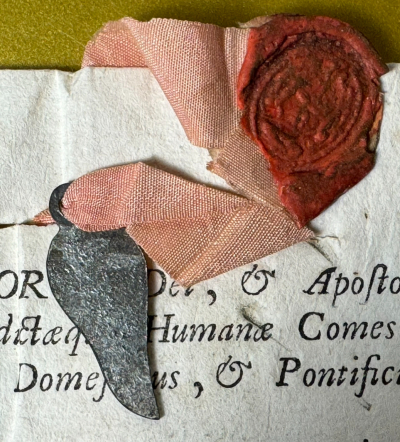Incredibly rare touch relic made from the silver object that touched the most powerful and mysterious Passion relic - The Holy Spear of Jesus also known as the True Lance. The reliquary is affixed to the original authentics document dated 1757 and issued and hand-signed by Fr. Nicola Manciforte (†1762), Bishop of Ancona.
The document written in Latin translates as:
"...that this silver tip of a Lance, tied to this [letter] with a ribbon of red color, and secured with a small Seal of ours impressed in Spanish Wax, touched the Very Sacred Point of the Lance with which the Side of the Savior was pierced while he was hanging on the Cross; that it exists amongst the rest of the quite famous Relics, by the possession of which our Church was distinguished as the Cathedral of St. Cyriacus; and that it rouses and fosters the piety of the Faithful wondrously well, and draws them to itself...."
The Holy Spear is also known as the Holy Lance is the name of the very spear that had pierced Christ’s side when he hanged on the cross. The first person to refer to this as the Holy Spear was pilgrim Antoninus of Piacenza in 570 AD. While describing the holy places of Jerusalem, he said that in the Basilica of Mount Zion, there was the crown of thorns which Our Lord was crowned and the spear which was used to strike Him in the side. It was rediscovered by the European army of the First Crusade in the city of Antioch on June 15th, 1098, but eventually ended up in the treasury of Constantinople. It is documented that the holy relic of the True Lance passed through Ancona (an Italian city on the Adriatic side of the Peninsula), in 1492 on its way from Bayezid II the Turkish Sultan (whose father obtained it in 1451 during the conquest of Constantinople) to Pope Innocent VIII by the hand of Pierre d'Abusson, Grand Master of the Knights of Rhodes. The Pope placed it in the Treasury of the old St. Peter's Basilica in Rome with the volto santo, where it is held in great veneration. It is now in one of the great piers of the present St. Peter's Cathedral and in front of it, over the image of Longinus is inscribed "The Spear of Longinus, which Innocent VIII, the Chief Pointif received from Bayezid Sultan of the Turks; Urban VIII transferred it to a decorated shrine rasing an image and erecting the shrine beneath." (see for more information: Relics from the Crucifixion: Where They Went and How They Got There. By J. Charles Wall.)
Since there are no records of the Cathedral of Ancona retaining a part of the True Lance when it was passing through the town on its way to Rome, it is believed that the offered relic was obtained by melting a larger silver object that touched the tip of the True Lance in 1492. A number of analogous documented reliquaries are known, but their number is extremely small and they are in very high demand because of the impossibility of making new touch relics from the True Lance held in the Vatican after it was transferred to the pier of St. Peter's basilica in the 17th century.










 Поменять язык на русский
Поменять язык на русский 